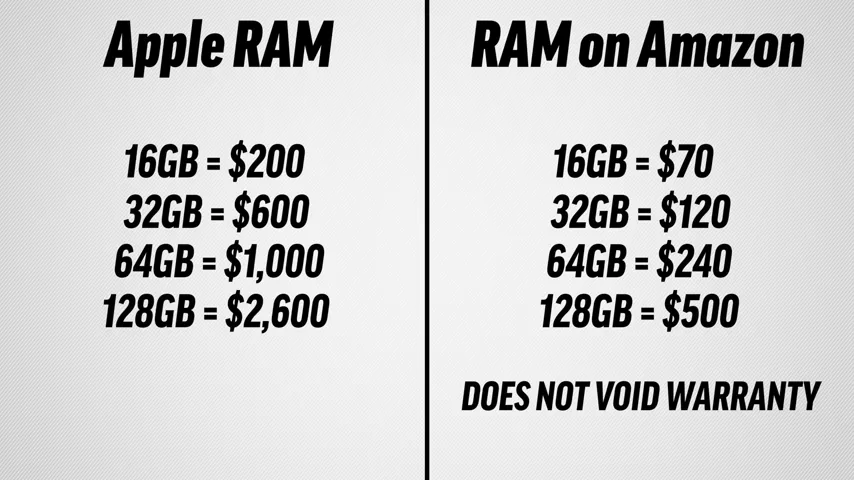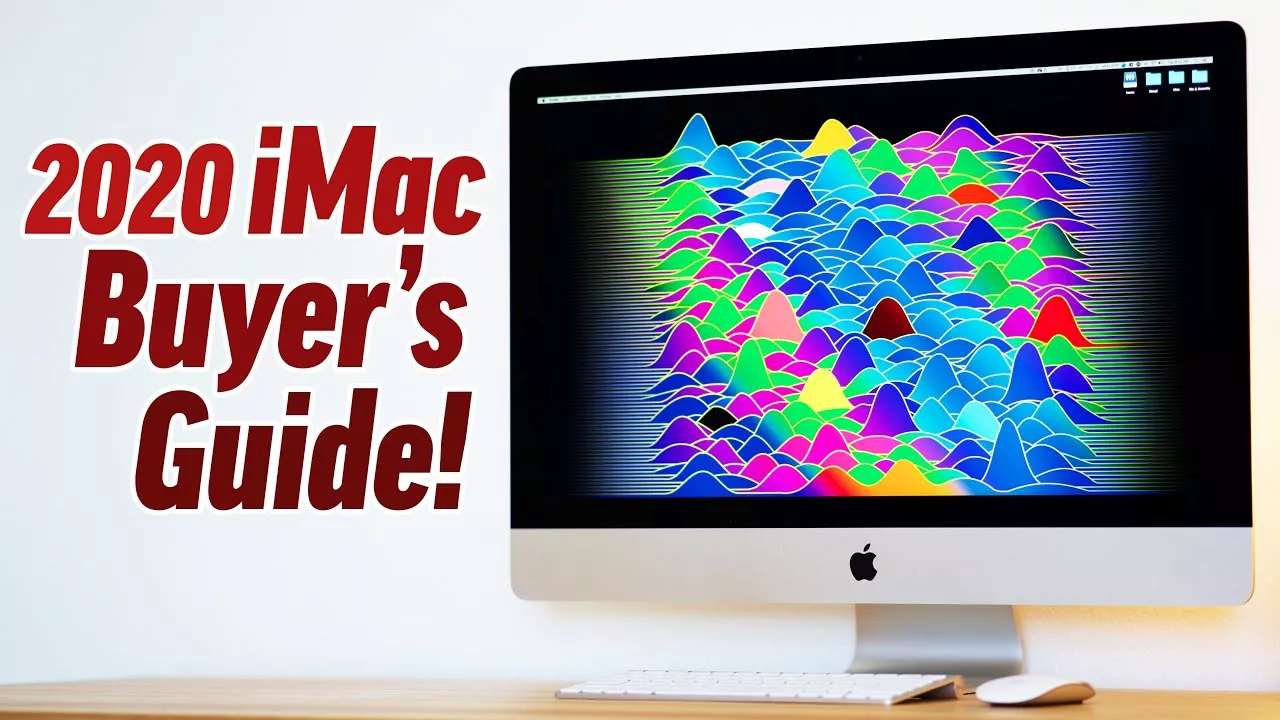Apple’s 2020 iMac is here, and I fully believe is the very last Intel iMac ever, and it’s going out with a bang. It’s an absolute powerhouse of a machine, but it also now has more upgrade options than ever before, making it tough to figure out which model and which upgrades to buy for your specific use-case. In this article, I’m gonna talk about 8 mistakes you should avoid when buying a 2020 iMac, and then I’m gonna break down which upgrades you should buy for different use cases like for casual users, photo editors, programmers, Logic Pro users, gamers, video editors and more.
1. Buying the nano-texture glass option for $500
Yes, it’s probably the best way to get a matte display without using a film that ruins colors and contrast, but for $500, unless you sit right next to a huge window, it’s definitely NOT worth it. The nano-texture glass actually does reduce display sharpness, not as much as other matte displays, but it still does, and the iMac is already so bright that for most reflections aren’t really an issue, so keep that $500 for something else.
2. DO NOT BUY the 21.5” iMac for three reasons
First off, it hasn’t been upgraded at all except for coming with an SSD at the base price. Second, you can’t upgrade the RAM yourself like you can in the 5K model, and third, we’re expecting this smaller iMac to get replaced with a new 24” Apple Silicon iMac either at the end of the year or in the first quarter of 2021.
3. DO NOT PAY for Apple’s Memory upgrades
 Simply leave it at the 8GB option, even if you get a fully-specced out iMac. And that’s because Apple greatly overcharges for RAM, and you can actually buy RAM yourself from Amazon, so you can save up to $2,100 on 128GB of RAM and it doesn’t void your warranty. And if you’re not sure about how to do it, it’s actually incredibly easy and we already created a RAM upgrade tutorial, so definitely check that out.
Simply leave it at the 8GB option, even if you get a fully-specced out iMac. And that’s because Apple greatly overcharges for RAM, and you can actually buy RAM yourself from Amazon, so you can save up to $2,100 on 128GB of RAM and it doesn’t void your warranty. And if you’re not sure about how to do it, it’s actually incredibly easy and we already created a RAM upgrade tutorial, so definitely check that out.
4. Not all upgrade options are visible on Apple’s 5K iMac listing page
For example, if you click on the $1800 model, you won’t have the option to upgrade to CPU or the graphics, but on the $2300 model, you can even configure the brand new 10-core CPU and you have access to 3 graphics options that are only available from this page, so be sure to check them all out.
5. Choose lower model and upgrade CPU if you don't care about graphics
If you really want the new 10-core CPU and you don’t care about graphics, you need to realize that you can actually select the middle $2000 model and pay $500 for that CPU upgrade, for a total price of $2500. If you would’ve chosen the highest end model and upgraded to that same 10-core CPU, your total would be at $2700, so you need to realize that you can save money this way because you’re not forced into getting better graphics if you don’t need it.
6. Overspending on upgrades you don’t really need
We believe that there is only a small number of people who the 10-core CPU is actually worth it for, and I’ll talk about it in just a minute in the Buyer’s Guide portion. So in reality, most people should be fine with either the 6-core or the 8-core CPU, and the same thing goes for graphics, there are some people who really won’t benefit from upgrading the graphics.
7. Don’t accidentally miss out on the 10 gigabit ethernet upgrade option for only $100
This one could be very important because if you don’t get it right away, you won’t be able to upgrade it yourself in the future. And because this new 5K iMac DOES NOT have WiFi 6, anybody who has or might potentially get Fiber internet in the future, should definitely pay for this 10gb ethernet upgrade. And the same thing goes for anyone who wants to use a NAS server in the future, since you need 10gb ethernet for the fastest transfer speeds. And even if you don’t fit into one of those categories, it might make sense to still pay the extra $100 for this because it’ll help the resale value in the future when you decide to sell this iMac, since there may be people who really want that 10gb ethernet port.
8. Be wise about how much storage you buy, because it’s NOT user upgradable
With the base model, you’re stuck with only 256GB of storage, so you’ll have to choose the $2000 model which gives you 512GB of storage and some extra options. I think the 1TB SSD option makes a TON of sense if you want to be safe, especially since it’s only $200 more. But on the other hand, if you’re getting the best $2300 model, don’t go out and upgrade to 8TB of storage because that’s simply insane and way more than most people will need, and you’re literally paying more for that upgrade than the entire iMac itself.
So now that we’ve dealt with all of those purchasing mistakes, let’s get into the buyer’s guide portion.
If you’re more of a casual user who wants a 27” iMac for things like web browsing or using web-based apps like Microsoft office and things like that, then the base $1800 model could actually be a great choice for you, but keep in mind that it’s limited to a 256GB SSD, so you may want to go for the $2000 model for more storage and the small boost in processor performance. Now if you’re wanting to do some Photo Editing, but it’s more of a hobby instead of professional work, the $2000 model should honestly be a great choice for you, and we recommend getting a 1TB SSD and then buying a 32GB kit from Amazon and adding it to the existing RAM that comes with the iMac for a total of 40GB, which is more than enough for you.
If you’re a high-end photo editor that takes your work very seriously, then you should definitely get the $2300 model with the 8-core CPU. Absolutely do not upgrade the graphics from the standard 5500 XT because it really doesn’t help photo editing, and it’s definitely not worth the extra cash to upgrade unless you also do graphics-intensive work or gaming. And honestly, we don’t think the 10-core CPU is worth it for 99% of photo editors because it’s pretty expensive at $400, and we don’t think it’ll make a big enough performance difference to justify the price. RAM, on the other hand, is very important for photo editing, so we’d recommend getting at least 64GB from Amazon.
Moving onto programmers, a beginner or casual programmer should probably be fine with the $2000 5K iMac, just be sure to get at least a 32GB Kit of RAM. For a high-end professional programmer, the 10-core CPU might actually make sense if you’re dealing with very large projects that take a long time to compile, and we’d recommend at least 64GB of RAM. And absolutely don’t upgrade the graphics.
For a Logic Pro X user, I honestly think the 8-core CPU will be good enough for 99% of users, so only the people doing massive audio projects should go for the 10-core, and for that, it might actually make sense to go all the way up to 128GB of RAM. And also, keep in mind that graphics won’t do anything for music production at all.
If you’re a gamer, especially if you want to use boot camp, the very first upgrade you NEED to make is go for the 5700 XT graphics card upgrade, before anything else, because this is currently our favorite AMD card available and the one we use for our eGPU setups. We don’t recommend the $300 5700 upgrade because it has quite a bit less performance than the 5700XT, so I would honestly recommend just paying the extra $200 for the 5700 XT, even if you have to stick with the base 8GB of RAM for a while before you can save up some money for some more RAM from Amazon. And as far as how much RAM to buy, a 32gig kit should be more than good enough for gaming. And since recent games like Call of Duty Warzone take a massive amount of storage, I’d recommend boot camp users to get at least 1TB of storage, or maybe even 2TB so you can split it and give 1TB for Mac and 1TB for Windows in boot camp.
If you’re wanting to do virtual machine work, we recommend as much RAM as possible so you can split it up into the different VMs, and then the 10-core CPU might actually make sense as well, and definitely be sure to get as much storage as you think you’ll need.
Moving onto video editing, if you’re working with basic 1080P clips, or fairly simple 4K editing without using a lot of extra effects or LUTz, then the $2000 iMac will actually get the job done decently well with its 6-core CPU and Radeon Pro 5300 graphics card. For you, get a 32GB of RAM kit and add it to the existing 8gigs for a total of 40, which is more than good enough, and be sure to get at least a 1TB SSD if you’re not planning to use external drives.
And since every 2020 5K iMac comes with the T2 chip, you should be able to edit HEVC footage pretty well! But if you’re planning on taking video editing more seriously in the future, you might want to future-proof your iMac by going for the $2300 model.
For high-end video editing, the most important thing is the graphics, so we recommend going straight for the 5700 XT, which will be a great match for the 8-core CPU on the $2300 model. We honestly believe that the 10-core CPU isn’t worth it for video editing, since it only gives you around a 17% raw performance boost in terms of Geekbench 5 multi-core scores, and that’s without factoring in cooling limitations.
We think the ONLY people who should upgrade to the 10-core CPU are those constantly working with RAW footage, like 4K or 8K RAW. And as for the RAM, 64GB should be more than good enough for video editing, and you should probably get at least a 1TB SSD. And don’t forget about that 10 gigabit ethernet upgrade if you think you might be connecting to a RAID storage server in the future.
So there you go guys, that’s my Buyer’s Guide for the 2020 5K iMac.


No comments yet